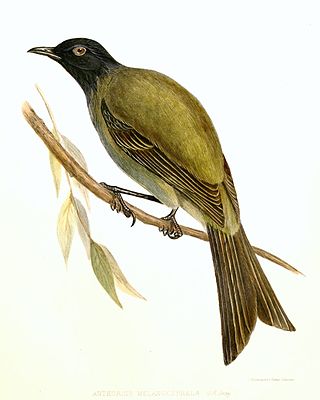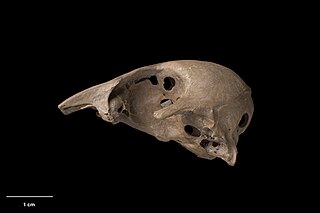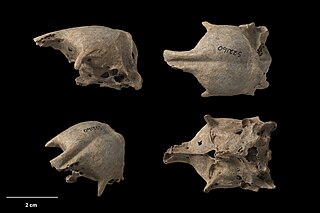
The bushwren, also known as the mātuhituhi in the Māori language, was a very small and almost flightless bird that was endemic to New Zealand. It had three subspecies on each of the major islands of New Zealand, the North Island, South Island, and Stewart Island / Rakiura and nearby smaller islands. The species disappeared gradually after the introduction of invasive mammalian predators, last being seen on the North Island in 1955 and the South Island in 1968. Attempts were made to save the remaining population on small islands off Stewart Island, but they ultimately failed with the death of the last remaining known birds in 1972.

The Auckland Island merganser, also known as the New Zealand merganser, was a typical merganser that is now extinct.

The piopio or turnagras are an extinct genus of passerine birds in the family Oriolidae, that were endemic to New Zealand. Sometimes described as New Zealand thrushes, the piopio had only a coincidental, passing resemblance to the thrush family.

The New Zealand raven was native to New Zealand, but has been extinct since the 16th century. There were three subspecies: the North Island raven, South Island raven, and Chatham raven from the Chatham Islands.

The eastern moa is an extinct species of moa that was endemic to New Zealand.
The Tasman starling was described in 1836 by John Gould as a species which occurred on both Norfolk Island and Lord Howe Island. In 1928 Australian ornithologist Gregory Mathews recognized that the plumage of the race from Lord Howe Island was much browner and more greyish than the plumage of the Norfolk Island race and split the species into two forms, the Norfolk starling, and the Lord Howe starling. Both subspecies are now extinct, thus so the species.

The austral snipes, also known as the New Zealand snipes or tutukiwi, are a genus, Coenocorypha, of tiny birds in the sandpiper family, which are now only found on New Zealand's outlying islands. There are currently three living species and six known extinct species, with the Subantarctic snipe having three subspecies, including the Campbell Island snipe discovered as recently as 1997. The genus was once distributed from Fiji, New Caledonia and Norfolk Island, across New Zealand and southwards into New Zealand's subantarctic islands, but predation by introduced species, especially rats, has drastically reduced their range.
The long-billed wren is an extinct species of New Zealand wren formerly endemic to the South Island of New Zealand. It was the only species in the genus Dendroscansor. It shares the name "long-billed wren" with the Brazilian bird Cantorchilus longirostris.

Finsch's duck was a large terrestrial species of duck formerly endemic to New Zealand. The species was possibly once the most common duck in New Zealand, a supposition based on the frequency of its fossils in bone deposits.

The New Zealand bittern is an extinct and enigmatic species of heron in the family Ardeidae. It was endemic to New Zealand and was last recorded alive in the 1890s.

The Chatham Islands bellbird or kōmako is an extinct species of bird in the family Meliphagidae. It was endemic to the Chatham Islands.

The New Zealand stiff-tailed duck is an extinct duck species from New Zealand which is known only from subfossil remains. It was first described as a distinct species by Trevor H. Worthy in 2005.
Scarlett's duck is an extinct duck species from New Zealand which was closely related to the Australian pink-eared duck. The scientific name commemorates the late New Zealand ornithologist and palaeontologist Ron Scarlett who discovered the holotype in 1941. However, previously undescribed bones of the species found in 1903 were rediscovered in the Otago Museum in 1998. At least 32 fossil remains from deposits in Pyramid Valley, at Ngāpara in the South Island, and at Lake Poukawa in the North Island are in museum collections.

Mantell's moa also known as Mappin's moa or moa ruarangi is an extinct species of moa from the North Island of New Zealand. Its habitat was the lowlands. The moa were ratites, flightless birds with a sternum without a keel. They also have a distinctive palate. The origin of the ratites is becoming clearer as it is now believed that early ancestors of these birds were able to fly and flew to the southern areas that they have been found in.

The New Zealand goose is a bird of the extinct genus Cnemiornis of the family Anatidae, subfamily Anserinae. The genus, endemic to New Zealand, consisted of two species: the North Island goose, C. gracilis and the South Island goose C. calcitrans.
Scarlett's shearwater is an extinct species of seabird in the petrel family Procellariidae. Its common name commemorates New Zealand palaeontologist Ron Scarlett, who recognised the bird's subfossil remains represented a distinct species.

The Norfolk triller was a small passerine bird in the cuckooshrike family, Campephagidae. It is the extinct nominate subspecies of the long-tailed triller which was endemic to Norfolk Island, an Australian territory in the Tasman Sea between Australia and New Zealand. Little is known of its biology.

The snipe-rail is an extinct flightless rail endemic to the North Island of New Zealand. The species' name is derived from the Karamu Cave 21 kilometres (13 mi) from Hamilton where the holotype was discovered in 1954.

The New Zealand musk duck, also known as de Lautour's duck, is an extinct stiff-tailed duck native to New Zealand. It is only known from subfossil bones. It was 10 percent larger than its closest living relative, the Australian musk duck Biziura lobata, with which it has sometimes been combined.

Anas chathamica, the Chatham duck or Chatham Island duck is an extinct species of duck which once lived in New Zealand's Chatham Islands in the south-west Pacific Ocean. It likely became extinct in about the 16th century because of hunting by humans.

















